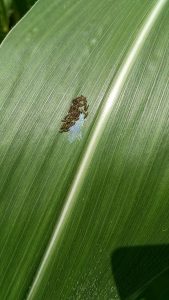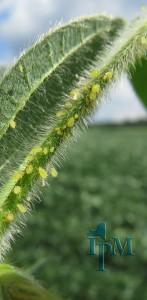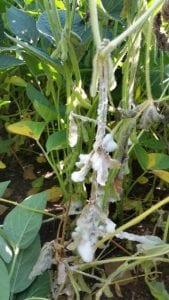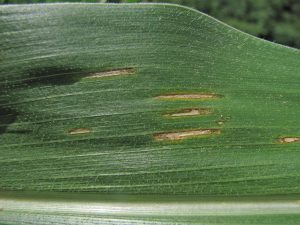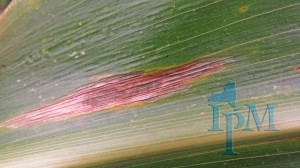July 30, 2021
Contents
Western Bean Cutworm
Western bean cutworm flights have dramatically increased over the last two weeks. Northern NY has by far the largest moth counts the last two weeks. There have been moderate to high moth counts in western NY. It is time to scout your corn. Peak flight of the moth will likely occur this coming week. It is time to get out and scout for eggs laid on the leaves. You are looking for small egg masses and small 1st instar larvae. See the table below for moth counts.
For more information, please view the following information: Western Bean Cutworm, Video on scouting western bean cutworm
Soybean Aphids
Soybean aphid levels have fallen. Many times when we have wet weather a pathogen builds up in a population of aphids and kills them. It has been reported that this might be the case with the recent reduction in the soybean aphid population. Please note that scouting should continue through the R5-R6 stage of growth.
For more information, please view the following publication or video.
A Visual Guide to Counting Soybean Aphids
Video on IPM for Soybean Aphids on Soybeans
White Mold in Soybeans
Conditions are very good for white mold to develop in soybeans. Note that a fungicide application has to be timely before the infection has started. For more information, view the following scouting video and publication: White Mold or Sclerotinia Stem Rot
Gray Leaf Spot on Corn
Gray leaf spot has started to show up in field corn in some areas of the state. The wet weather has created the conditions to increase the risk of gray leaf spot. The good thing is that many of the hybrids are moderately or highly resistant to this disease now. For more information, view the website: Gray Leaf Spot
Northern Corn Leaf Blight
Northern corn leaf blight has started to show up in field corn in some areas of the state. The wet weather has created the conditions to increase the risk. For more information, view the website: Northern Corn Leaf Blight
Northern Stem Canker
Northern stem canker was found in soybeans in northern NY this last week. This disease can cause economic losses in soybeans. For more information, view the following publication: Northern Stem Canker
Western Bean Cutworm Moth Flight Counts
This is the number of western bean cutworm moths that were caught in bucket traps by location.
| County | Town | 7/4/2021 | 7/11/2021 | 7/18/2021 |
| Cayuga | Aurora | 3 | 67 | 169 |
| Cayuga | Sterling | 0 | 1 | 32 |
| Cayuga | Springport | 0 | 7 | 20 |
| Cayuga | Aurelius | 30 | ||
| Chenango | Oxford | 1 | 0 | 12 |
| Clinton | Chazy | 2 | 13 | 228 |
| Clinton | Champlain | 1 | 15 | 100 |
| Clinton | Beekmantown | 0 | 11 | 317 |
| Clinton | AuSable | 5 | 275 | 503 |
| Cortland | Homer | 0 | 2 | 11 |
| Cortland | Cortland | 7 | 30 | |
| Cortland | Preble | 1 | 19 | 194 |
| Chenango | Oxford | 0 | 0 | 12 |
| Cayuga | Cato | |||
| Cayuga | Venice | |||
| Delaware | Walton | |||
| Delaware | Walton | |||
| Dutchess | Amenia/Millbrook | 0 | 2 | 8 |
| Essex | Willsboro | 0 | 19 | 124 |
| Essex | Willsboro | |||
| Essex | Westport | |||
| Franklin | Banger | 0 | 0 | 425 |
| Franklin | Malone | 4 | 7 | 525 |
| Franklin | Chateaugay | 2 | 0 | 27 |
| Genesee | Oakfield | 8 | 81 | |
| Herkimer | Poland | 2 | 7 | 66 |
| Jefferson | Calcium | 9 | 80 | 448 |
| Jefferson | Ellisburg | 2 | 255 | 536 |
| Jefferson | Hounsfield | 1 | 56 | 216 |
| Jefferson | Plessis | 0 | 56 | 161 |
| Jefferson | Rutland | 0 | 4 | 339 |
| Jefferson | Henderson | 9 | 102 | 380 |
| Lewis | Lowville-1 | 0 | 12 | 593 |
| Lewis | Lowville-2 | 7 | 52 | 409 |
| Lewis | Turin | 1 | 24 | 110 |
| Lewis | Martinsburg | 0 | 0 | 182 |
| Monroe | Hamlin | 0 | 243 | |
| Madison | Munnsville | 0 | 0 | 1 |
| Montgomery | Canajoharie | 0 | 0 | 24 |
| Niagara | Barker | 13 | 202 | |
| Otsego | Cherry Valley | 0 | 0 | 0 |
| Saratoga | W. Charlton | |||
| Schoharie | Central Bridge | 0 | 0 | 3 |
| St. Lawrence | Oswegatchie | 22 | 219 | |
| St. Lawrence | Dekalb | 17 | 187 | |
| St. Lawrence | Madrid | 24 | 775 | |
| St.Lawrence | Lisbon | 33 | 840 | |
| St.Lawrence | Waddington | 6 | 275 | |
| St.Lawrence | Brasher | 96 | 1050 | |
| St.Lawrence | Lawrence 1 | 16 | 600 | |
| St.Lawrence | Lawrence 2 | 27 | 410 | |
| Suffolk | Riverhead | 0 | 0 | 5 |
| Ulster | Hurley1 | 0 | 6 | 6 |
| Ulster | Hurley2 | 0 | 0 | 0 |
| Wanye | Walworth | 24 | 73 | |
| Saratoga | W. Charlton | 1 | 15 | 90 |
| Saratoga | Gansevoort | 1 | 1 | 38 |
| Saratoga | Wilton | 8 | 37 | 31 |
| Washington | Easton | 0 | 8 | |
| Washington | Easton2 | 5 | 65 | |
| 7/4/2020 | 7/11/2020 | 7/18/2020 | ||
| Traps Reporting | 48 | 50 | 43 | |
| WBC Total | 315 | 5576 | 7068 | |
| Avg WBC / Trap | 6.5 | 111.5 | 162.9 | |
| “0” WBC | 20 | 12 | 2 | |
| > 0 WBC | 28 | 38 | 41 | |
| % Traps Catching | 58.3% | 76.0% | 95.3% | |
| Accum Total forSeason | 331 | 5907 | 12975 |
Clipboard Checklist
Keith Waldron, NYS IPM
General
*Walk fields to check general field condition, weed, vertebrate and other issues
*Watch for crop maturity, stand assessments, weed escapes, nutrient deficiencies, lodging issues
Alfalfa:
*Evaluate established legume stands for approximate days until harvest
*Monitor potato leafhopper, foliar, systemic and crown rot diseases.
*Monitor new seedings for potato leafhopper, pythium blight, phytopthora root rot.
Small Grains:
*Monitor grain fields for growth stage, disease and lodging issues, grain maturity, harvest timing
*Record diseases present, location and types of weed escapes
Corn:
*Monitor for mid-season corn pests including European corn borer, corn rootworm, western bean cutworm, slugs, foliar diseases such as northern corn leaf blight and gray leaf spot, weed issues, nutrient deficiencies, vertebrate damage.
Soybeans:
*Monitor for soybean aphid, defoliators, foliar diseases, white mold, weed issues, vertebrate damage
Pastures:
*Check water sources, mend fences as needed.
*Check crop growth, clip pastures between grazing as needed
*Monitor for invasive species, plants harmful to livestock
*Review/Plan rotations
Storage:
* Check stored grain bins for temperature, moisture and signs of mold and insects. Aerate, core, transfer grain or treat as necessary
* Clean and disinfect empty storage bins in preparation for grain harvest
*Check forage allocation and anticipate feed program adjustments as forages from previous year are used up
*Mow around storage bins and facility to minimize pest hiding places
Dairy Cattle Barn Fly Management:
*Monitor animals and barn area for house fly, stable fly and other pest management needs including presence of rodents and birds.
*Check facilities for favorable fly breeding conditions: (organic matter + moisture): leaks in watering systems, roof gutters for leaks and potential overspill, drainage,
*Sanitation, sanitation, sanitation – clean animal resting areas, feed troughs, minimize source of moist organic matter i.e. fly breeding areas in barn and in adjacent animal loafing yard
* Continue fly monitoring: install “3X5″ index card fly speck monitoring cards throughout barn
*Use, replenish, replace fly management materials: sticky fly tapes/ribbons, insecticide baits, natural enemies (parasitoids), fly population monitoring (3 x 5) spot cards
*Consider purchase and release of Muscidifurax raptor and/or M. raptorellus natural enemies of house and stable fly pupae.
Dairy Cattle on Pasture:
*Monitor animals for presence of face flies, horn flies and stable flies. Action guidelines: face flies (average 10 per animal face), horn flies (average 50 / dairy per animal side, 200 / beef cattle per animal side), stable flies average 10 per animal (all four legs)
*Check feed bunk / water source locations for signs of stable fly breeding (moist undisturbed organic matter – spilled feed, round bales, etc.), minimize source of moist organic matter i.e. fly breeding areas in barn and in adjacent animal exercise yard.
*Check pasture for forage quality / quantity, rotate as appropriate
*Check pasture for vegetation poisonous to livestock
*Consider use of pasture fly traps to help reduce deer, horse and stable fly populations



